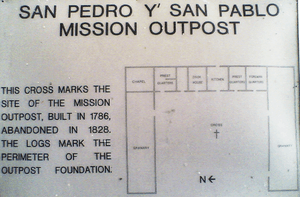San Pedro y San Pablo Asistencia
The San Pedro y San Pablo Asistencia was established in 1786, as a "sub-mission" to Mission San Francisco de Asís in the San Pedro Valley at the Ohlone village of Pruristac. The site is located within the bounds of the Rancho San Pedro (home to the Sánchez Adobe) in what today is the town of Pacifica.
 The perimeter of the outpost's foundation is outlined with logs. | |
 Location on the San Francisco Peninsula  San Pedro y San Pablo Asistencia (California) | |
| Location | Pacifica, California |
|---|---|
| Coordinates | 37°35′14″N 122°29′36″W |
| Name as founded | Asistencia de la Misión San Francisco de Asís |
| English translation | Sub-Mission of the Mission San Francisco de Asís |
| Patron | Saint Peter and Saint Paul |
| Founding date | 1786 |
| Military district | Fourth |
| Native tribe(s) Spanish name(s) | Ohlone Costanoan |
| Native place name(s) | Pruristac |
| Governing body | County of San Mateo |
| Current use | Museum |
| Designated | 1976 |
| Part of | Sánchez Adobe |
| Reference no. | #NPS–76000525 |
| Designated | 1947 |
| Part of | Sánchez Adobe |
| Reference no. | #391 |
History
Within the first year a chapel, granary, tack room, and three other rooms had been constructed, using native labor. In 1788 two more rooms were added. In 1789 a second granary was built, quarters for the mayordomo, and quarters for the missionaries were built. Also, a covered passageway which temporarily served as a kitchen. Crops of wheat and beans were planted in quantities to provide for the needs of the parent mission. At its peak the asistencia consisted of a three-wing main structure surrounding a central plaza. Corn, peas, barley, asparagus, and rosemary would, in time also be cultivated, along with grape vineyards and groves of peach and quince trees. Due to a significant decline in the native population, the facility was used mainly as an outpost to graze cattle after 1790.

After secularization of the missions in 1834, Juan Alvarado, the Mexican Governor of California, granted the lands of the 8,926-acre (36.12 km2) Rancho San Pedro to Francisco Sanchez in 1839. Included were all of the buildings of the Asistencia. Sanchez retained ownership of the property after California was ceded to the United States in 1848. In 1894, roof tiles were salvaged from the property and installed on the Southern Pacific Railroad depot located in Burlingame, California (the first permanent structure constructed in the Mission Revival Style). Today, little remains of the original installation.
References
- Jones, Terry L. and Kathryn A. Klar (eds.) (2007). California Prehistory: Colonization, Culture, and Complexity. Altimira Press, Landham, MD. ISBN 0-7591-0872-2.CS1 maint: extra text: authors list (link)
- Paddison, Joshua (ed.) (1999). A World Transformed: Firsthand Accounts of California Before the Gold Rush. Heyday Books, Berkeley, CA. ISBN 1-890771-13-9.CS1 maint: extra text: authors list (link)
- "San Mateo Environmental Services Agency" (PDF). Sánchez Adobe Historical Site: Draft Master Plan. Archived from the original (PDF) on August 31, 2005. Retrieved July 26, 2006.
- "Spanish Colonization in San Mateo and Santa Cruz Counties". Retrieved July 25, 2006.